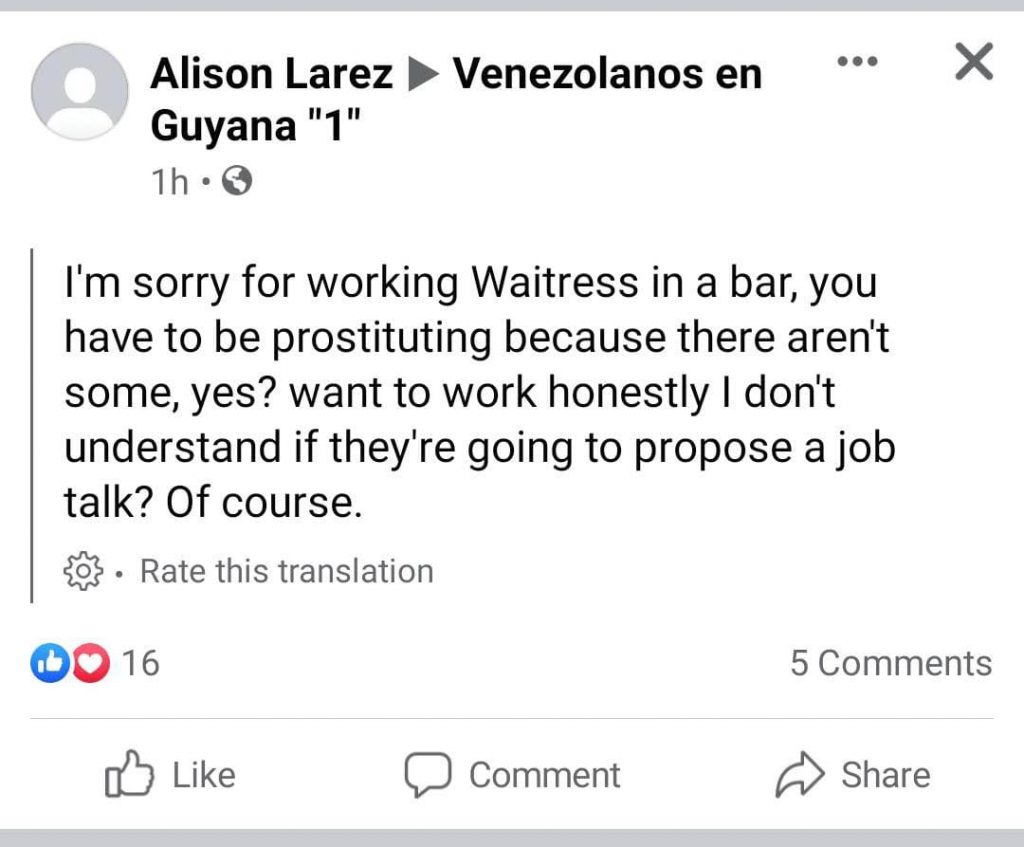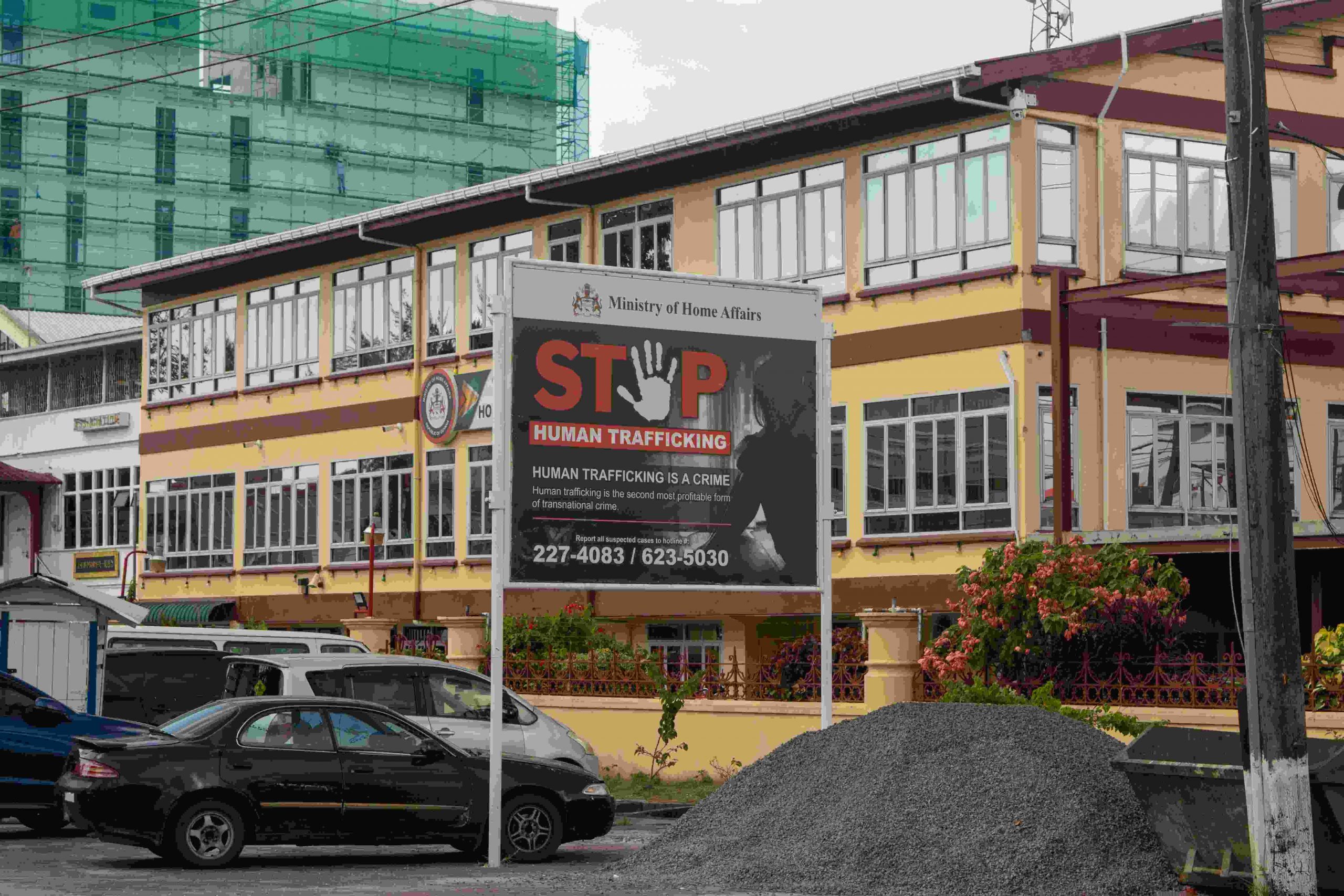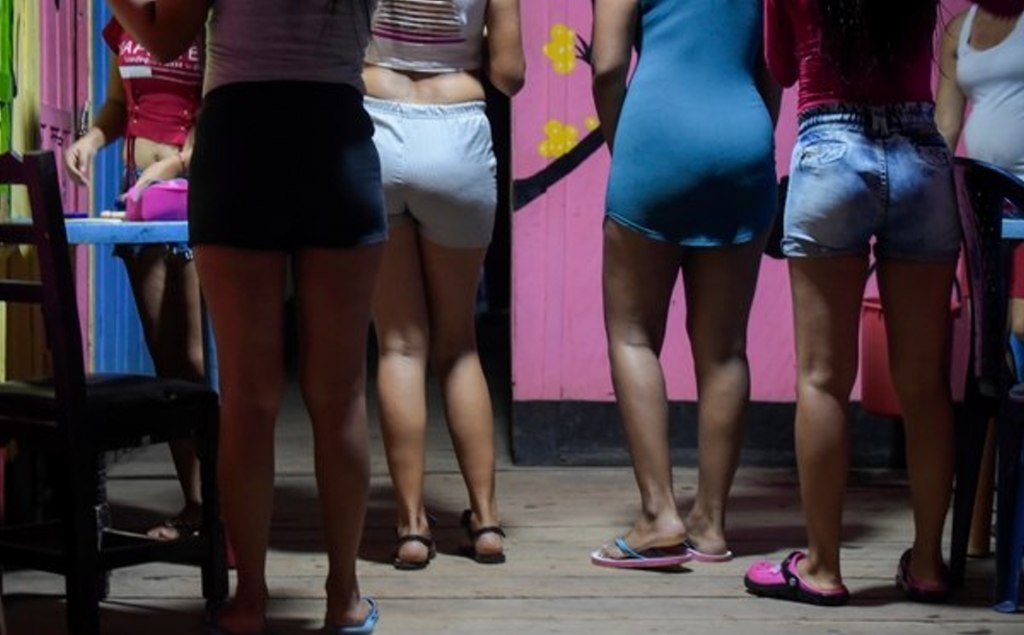Many of the trafficked Venezuelan women who gave testimonies claim that they are most times cramped inside rooms with other women.
Sexual trafficking here has become one of the most prevalent risks for Venezuelan women, with mining sites becoming hotspots for this kind of exploitation. They are lured with false promises of employment and a good life in Guyana, then beaten, or threatened with violence, and imprisoned. They often feel helpless and hopeless, and eventually, stop trying to escape. Although the Guyanese Government has tried to tackle the problem, the number of cases remains unabated. This investigation sheds light on the plight of Venezuelan women in Guyana—the recruitment practices, the routes, the sites of exploitation and an understaffed police force that struggles to identify the victims.
By Samuel Sukhnandan
The enthusiastic 22-year-old resident of San Felix, Venezuela did not hesitate to respond to the message. In fact, she didn’t even think twice before saying yes to the job offer to work in a retail store in a country that is becoming popular owing to its mining activity and its massive oil discoveries. The message came from an old high school friend (Rayli).
But she was duped into coming to Guyana. Her journey to the only English-speaking South American country ended with her being locked away in a hotel room for days, before she was finally taken in to the Guyanese jungle to work in the mines as a sex worker.
Like Fabiana, over 337 Venezuelan migrants under the age of 27 have been trafficked to Guyana since 2018. This is according to a 2020 Organisation of American States (OAS) study.
Human trafficking remains a huge business and those behind it often get off scot-free. Based on this investigation published by CONNECTAS, it was found that many of the victims are recruited through deceptive means, but some are also told upfront that they would be engaged in sex work. All are subjected to different types of violence and abuse.
This investigation is based on the testimonies of seven victims, official reports, information from anti-Trafficking in Persons organisations and multiple sources that have close contact with the persons linked to these schemes.
False job advertisements and recruitment through other victims are common methods used by traffickers. And according to the International Organisation for Migration (IOM), the political turmoil, socio-economic instability, and the ongoing humanitarian crisis have led to more than 5.9 million refugees and migrants leaving Venezuela within the past couple of years. Among them, women who end up trapped in sexual trafficking.
This was the case of Fabiana, who was given US$500 for her journey to Guyana. She told her family that she was going to work for a few months and that she would send some money back home.
With both of her parents unemployed, and a 14-year-old brother at home, Fabiana felt she needed to help and what better way to do it than through a well-paid job.
But her parents and her boyfriend were not comfortable with the idea; nonetheless, Fabiana was hell-bent on making the journey. She reassured them that her friend Rayli could be trusted and that she would be okay and would contact them often.
When Fabiana arrived in Guyana, she was not received by her friend. In fact, she was cleared by an immigration official at the border between Guyana and Venezuela in Region One. She was then picked up by a taxi driver, and taken to a hotel in Port Kaituma, a small village in that same region. This area serves as the gateway to the Guyanese jungle where predominantly small-scale gold mining takes place.
Fabiana was joined by at least eight other girls and spent nearly three days in the community before she was transported to a mining area, where she met her long-lost high school friend, who was working with a man who operated some small mines. Fabiana was then told that there were no sales girl jobs available anymore at the store, and she would have to sell her body.
A shocked Fabiana immediately knew that she was trapped, as she already had a debt of US$500. “Disappointed, hopeless, angry, and confused,” was how she described her state of mind at that exact moment.
“I cried so much at first. The hotel became a home, and I was now doing full-time sex work at the crack of dawn and sometimes going into the jungle. I would sleep with random men, at least three to four some days,” she explained.
The allure of mining
Based on the US State Department’s Trafficking in Persons (TIP) report for 2021, women from Venezuela are sex trafficking victims in Guyana’s mining communities in the interior and urban areas.
Mining is a major contributor to the Guyanese economy, owing to sizable reserves of bauxite, gold, diamonds, and other minerals. The sector employs hundreds of Guyanese, mostly men, and migrants. Traffickers are attracted to Guyana’s interior mining communities where there is limited government control and the demand for sex workers is high, according to a previous US TIP report.
And according to the R4V Report of August 2020, in Regions 1, 7, 8 and 9, settlements are near mines and boast high concentration of hotels, bars and night-clubs, where sex traffickers exploit vulnerable individuals. This investigation confirmed the existence of settlements, where the exploitation takes place surreptitiously.
Popularly known as the gateway to the gold and diamond mining regions of Guyana, Bartica is a town in Region Seven which lies at the confluence of the Essequibo, Cuyuni, and Mazaruni Rivers.
Paula, 23, was promised a decent job in the hospitality industry in Guyana. Having worked for a hotel in Ciudad Guayana, Bolivar State in Venezuela, she felt she had what it took to not only secure a job in Guyana but progress in the field.
She first arrived at Eteringbang in 2017, and made her way to the township of Bartica. There, she was given a room and met with Spanish-speaking girls like herself both from Venezuela and the Dominican Republic.
She assumed they were all going to do the same job, serving guests and assisting with booking rooms, among other duties. When she enquired from the girls, she was told to speak to the boss first and then she would know what role would be given to her.
Two days later, she was called and introduced to someone who claimed that he was not the owner of the hotel, but he would be her boss. Her passport was taken away and she was denied access to her cellular phone.
She attempted to leave, but no one would talk to her or help her. She was warned by the other girls that she would be in grave danger if she attempted to escape.
Paula was later forced to sleep with men in exchange for money that she only got a percentage of. While she was able to send money back home to her family, she was not allowed to do it herself. Her phone calls were monitored and she was closely watched every time she had a client. To make matters worse, every wrong move she made or complaints the boss received landed her in huge debt and other forms of punishment.
After one year, she had made enough friends and planned an escape. Word got around every attempt she made, and the boss would threaten her or starve her of food and cash.
Paula eventually stayed on for two more years. She told this investigation that she became used to the work and the abuse and asked herself, “why escape now, when I’m already in it and don’t know anything else besides this.”
But she mustered up the courage to leave eventually when she saw younger women were recruited and brought to work in the mining areas. They were in greater demand, and she was seen as useless. In fact, Paula admits that most of the men requested them. Seeing them also brought back memories of how she was recruited and brought to Guyana at age 19.
She managed to leave eventually and now resides in the country’s capital city, Georgetown.
Reina (not real name) came to Guyana through another route, the Cuyuni River. This river is one of three major migration routes from Venezuela into Guyana. The border village of Eteringbang is located on the western side of the Essequibo region, in dense rainforest, and is one of the most remote villages in the country.
It is considered riskier and highly dangerous since armed groups such as the syndicatos operate from the Venezuela border nearby. The syndicatos are violent organisations related to illegal mining that operate at the border between Guyana and Venezuela, close to the Cuyuni river. Eteringbang has nightclubs, brothels, and restaurants, which cater to men who work in the gold mines.
The 21-year-old woman from San Martín de Turumbán worked non-stop sleeping with gold miners and those working in the mining pits in the region. “I knew what I was coming for, but I didn’t expect it to be this hard. The men were too abusive, even though they paid in gold. I had to escape,” she said.
A deceptive job offer paved the same trail for Bella, 20, recruited from Tucupita, Delta Amacuro in Venezuela. She was one of the 27 women who were arrested during a police operation in 2018 at Bikers Bar located at Covent Garden, East Bank Demerara. Twenty-five of them were Venezuelan.
Bella had worked for a company that manufactured dairy products in her native Venezuela, and while it isn’t an ideal job for young women, she was getting paid, though inadequately. So, when an offer for a job in Guyana came around, it brought a huge level of excitement to her.
“I got this message on my phone about a job opportunity in Guyana. I knew little about the place, but I heard that many people were going there. So, I wanted to see for myself if I could go and get my family there, because things were really hard,” she said.
Bella said she was told she would be paid in gold, and when converted into cash, it would earn her far more than what other foreigners made in other parts of the country. She recalled that the journey to Guyana took her days and she was hoping that it would be worth it.
She was first hired as a cook for the bar, but eventually became a sex worker. But she was never taken to any mining hubs, where a majority of the trafficked women are paid gold.
Bella told this investigation that she lived with several other girls in houses owned by the bar owners, who restricted and monitored all their movements, even when they were talking to potential clients. She also suffered mental and physical abuse at the hands of multiple men.

Parika is another busy port-of-entry on the East Bank of the Essequibo River for trafficked Venezuelan women.
Strategic traffickers
A significant number of trafficked victims have been rescued from the Mazaruni mining district, says President of the Guyana Women Miners Association (GWMO), Urica Primus. This is one of six mining areas in Guyana, which is home to small, medium and large-scale miners of gold, diamonds and other minerals.
The organisation rescues victims and provides shelter and additional support to them. More than 50 survivors have been in the organisation’s care over the past three years.
Although many cases of trafficking occur in Guyana’s interior region, particularly close to mining hubs, many Venezuelan women are also trafficked to work in bars, brothels and other entertainment clubs in the city, and coastal parts of Region Four, especially on the East Coast and East Bank of Demerara.
Recent data released by the Guyana Police Force Counter-Trafficking in Persons Unit has revealed that Venezuelan women were the most trafficked for 2021.
Their report, which was released in August this year, said there were 49 alleged human trafficking victims for the year—44 of them female. Of the 44, 34 are Venezuelan nationals.
CHART
A translator who worked recently with the Counter-Trafficking in Persons Unit under the Human Services Ministry, Maria (not real name) said the most common points where Venezuelan victims come from include: Bolivar state, Guayana City, San Felix, and Puerto Ordaz.
Maria told this investigation that each case is peculiar, but carries a similar story. In most cases, a lot of the women come from San Felix barge terminal. Sometimes, they also leave the terminal at San Felix or Puerto Ordaz for Santa Elena with an identification card to head to Brazil from which they head for the border town of Lethem, Guyana.
“The meeting point most times is Lethem, Region Nine; or Parika, Region Three,” she said, adding that there are other locations along the Essequibo coast.
Maria, who is fluent in English and Spanish, and has interviewed dozens of trafficked Venezuelan women in Guyana, claims that most traffickers are strategic and detailed in how they handle the transportation of these women.
“Everything is well planned and scheduled,” she added.
The former translator said that while relatives, friends and other individuals are engaged in the recruitment of these women, a Facebook group called “Venezolanos en Guyana ‘1’”, is also frequented by Venezuelans living here and those wishing to come to Guyana, for employment opportunities and travel advisories for both legal and illegal routes. Most of the women interviewed claim that this page is also used to traffic women from Venezuela.

A post made by an anonymous person in the Facebook group ‘Venezolanos en Guyana ‘1,’ where Venezuelans living here and those wishing to come to Guyana, visit for employment and other opportunities.
Once these women arrive in Guyana and are cleared by immigration officials or make their way through an illegal route, they stay at specific hotels that are booked before they make their journey to other permanent locations. However, Maria told this investigation that “the girls come with a low budget and most times from poor families and communities”.
Little room for escape
Keyamdreina (not real name), 24, a mother of three from Tucupita, Delta Amacuro journeyed to Guyana in August 2020 through Port Kaituma, Region One.
Key left her family behind in search of a job. Her intention was to get on the ground and make enough money to send for her children. She was told that there were many jobs for cooks in the mining industry in Guyana’s interior.
She says it took hours for her to get from her village to the border with Guyana. Hours more were spent travelling from Delta Amacuro to Region One, both by vehicle and boat.
She was eventually picked up by her childhood friend Martha, who had been living in Guyana for about two years prior. They had been communicating regularly via Facebook, which led Key to make the journey.
Martha took Key to the site of her new job, and she was told that she needed to begin working right away, cooking for people working in the mines.
She was given a room and was asked to meet with another woman in a small makeshift apartment in the middle of the thick Guyanese jungle. Then she was transported to another location close to mining pits, where she assisted in the kitchen.
Although she spoke both English and Spanish, it was difficult for her to understand everything, especially Guyanese Creole. So, when at times, she would hear the mine workers talking about sex and prostitution, she did not catch on, at first.
During that time, she didn’t have any contact with Martha, since she worked at another location. Key was also kept in a room separate from other women who worked there. It was only two days into her stay that she realized that the other women were selling their bodies.
It wasn’t long after becoming aware of the situation that she was told that she won’t be required to cook anymore and if she was approached by a miner that she would need to tell her boss.
When the time came and she told her boss, she was sent to her room and within minutes a man stepped inside. She was told to perform oral sex on the miner, which she eventually did. Soon, several men were frequenting her shack. She was paid in gold, but the woman she worked for kept it, promising to give it to her after the first three months.
Although she felt entrapped, Key said she had no other choice but to do as she was instructed, because she was told by the girls that there was little room for escape.
After being denied contact with her family for more than three months, Key felt she needed to find a way to escape. With the help of some of the women there, she was able to get out.
She immediately made contact with her family, and managed to return home. Although afraid to return at first, Key came with her family this year to Guyana through another friend who lives and works in the city.
She doesn’t have any intention of staying but trades in goods, taking them from Guyana to Venezuela. She is supported by others in her home country.
She did not want to provide any further details since she is afraid that the people with whom she worked might come after her or her friend Martha who lives in the interior.
Pressed for a name and exact location of the mining area, Key remained firm on her position that she would not like to say anymore that would jeopardize her or her friend. She said nothing is ever done for the women who are being trafficked, despite reports to the authorities.
The Guyana Women Miners Organisation, which runs one of five shelters for trafficked victims, told this investigation that while it has worked to return some survivors to Venezuela, most of them request support to get integrated into Guyanese society, due to the current economic challenges in their country of origin.
Many Venezuelan women use Charity, a small township in Region Two on the Pomeroon River, Essequibo Coast as an entry point to Guyana.
More could be done
The Guyana Women Miners Organisation President feels there is a need for more in-depth investigations. “A lawyer should be incorporated into the Police TIP unit for the purpose of taking the statements and advising on evidence to be collected for the strength of the cases. We are prosecuting; however, the cases are being thrown out,” she said.
Primus said the need for expedited prosecution is dire. “Some clients are notified that they have to attend court three to four years after being rescued, by that time they are moving forward with their lives and don’t wish to be reminded of that period of their life. As such, they refuse to attend the hearings.”
The organization provides safe housing for survivors to attend court and/or rehabilitative care services. The opportunity to complete their high school education or acquire a skill is also available to them. And the opportunity to benefit from professional counselling services, also exists, with one psychologist and two counsellors on staff.
Meanwhile, a fairly new civil society organization called VOICESGy, which provides critical support to Venezuelan migrants in Guyana, said it has referred several cases of trafficked Venezuelan women to the police and other international agencies. The organization’s Director, Charlie Tokeley feels there is a lack of awareness on what constitutes trafficking.
“Guyana seems to be faring very well in terms of the evaluation to its response to trafficking, but there is still more to be done one way or another…so efforts are being made to tackle the issue,” he stated, adding that there is a major shortage of counsellors who can provide these specialised services.
Meanwhile, VOICESGy’s Project Manager, Christian Vargas noted that given the challenges faced with effectively monitoring the extractive sector, which is the major hot spot for the trafficking of Venezuelan women in Guyana, there continues to be a rise in these cases. He feels that there is a need for a more effective coordination mechanism in place to ensure that the issue is rooted out and there is no overlapping of services offered to these victims.
In 2005, Guyana’s Parliament passed the Combating of Trafficking in Persons Act and established a national task force, including the Trafficking in Persons Unit in the Police Force and a Counter Trafficking Unit in the Ministry of Human Services and Social Security. A hotline for trafficking victims, and two shelters and other facilities are also run by the Ministry.
Nevertheles, the 2021 US TIP report recommended increased prosecution and convictions in sex trafficking cases. The report also called on the police to investigate trafficking cases in remote regions of the country, and work on delays in court proceedings and pretrial detention of suspects.
“Although the government meets the minimum standards, it did not prosecute as many traffickers or provide adequate screening and shelter for child and male victims; it also lacked capacity and training to identify and investigate trafficking cases in remote regions,” the report added.
Twenty-eight cases of suspected human trafficking were investigated by the Guyana Police Force from last August to April of this year, but only eight were placed before the courts.
This was disclosed by the country’s Human Services Minister, Dr Vindhya Persaud, who provided this detail to the Parliament in August this year, based on a request from the parliamentary Opposition.
In the previous year, the authorities reported 31 new investigations, with one new prosecution. Two persons were convicted, one trafficker in 2020, and one in 2019.
The Parliament was also told recently that there were only four full-time staff employed with the TIP Unit, which has direct responsibility for human trafficking operations across Guyana.
Furthermore, the Ministry of Home Affairs (National Security) has only one staff assigned to the Ministerial Task Force for TIP, which has 15 trained members; and the Police Force has three ranks assigned to its own Unit.

A billboard situated in front of the Ministry of Home Affairs (National Security) Brickdam, Georgetown, Guyana headquarters with an anti-trafficking message.
By the Government’s own admission, it lacks the manpower to effectively address this issue, “The Ministry is actively engaged in the process of expanding the staffing of the Unit in a bid to improve its capacity when responding to human trafficking across Guyana.”
The Guyana Police Force Counter-Trafficking in Persons (TIP) Unit 2020 Report said it has become difficult for law enforcement officers to detect instances of the crime. The police were asked for their comments, but no answer has been given until the publication of this investigation.
Restrictions imposed on indoor and public social gatherings to curb the spread of the COVID-19 pandemic have dampened the efforts to conduct countrywide inspections. In public declarations, the Force has said that the traffickers are now finding other means to lure their victims.
These include parties being held at private locations, advertisements of half-naked women on social media, escort services, and victims being delivered to the homes of clients.
It was also revealed that bar owners are also adopting similar strategies.
The identification of victims remains challenging in Guyana, especially in remote areas with weak institutional presence and fast-developing mining communities, as numerous reports acknowledge. But if the measures taken by the government only continue to comply with the minimum standards, more Venezuelan women will be expecting the same fate of others before them—the seemingly never-ending plight of Venezuelan women looking for a better future in other countries, but finding the trap of sexual exploitation instead.






